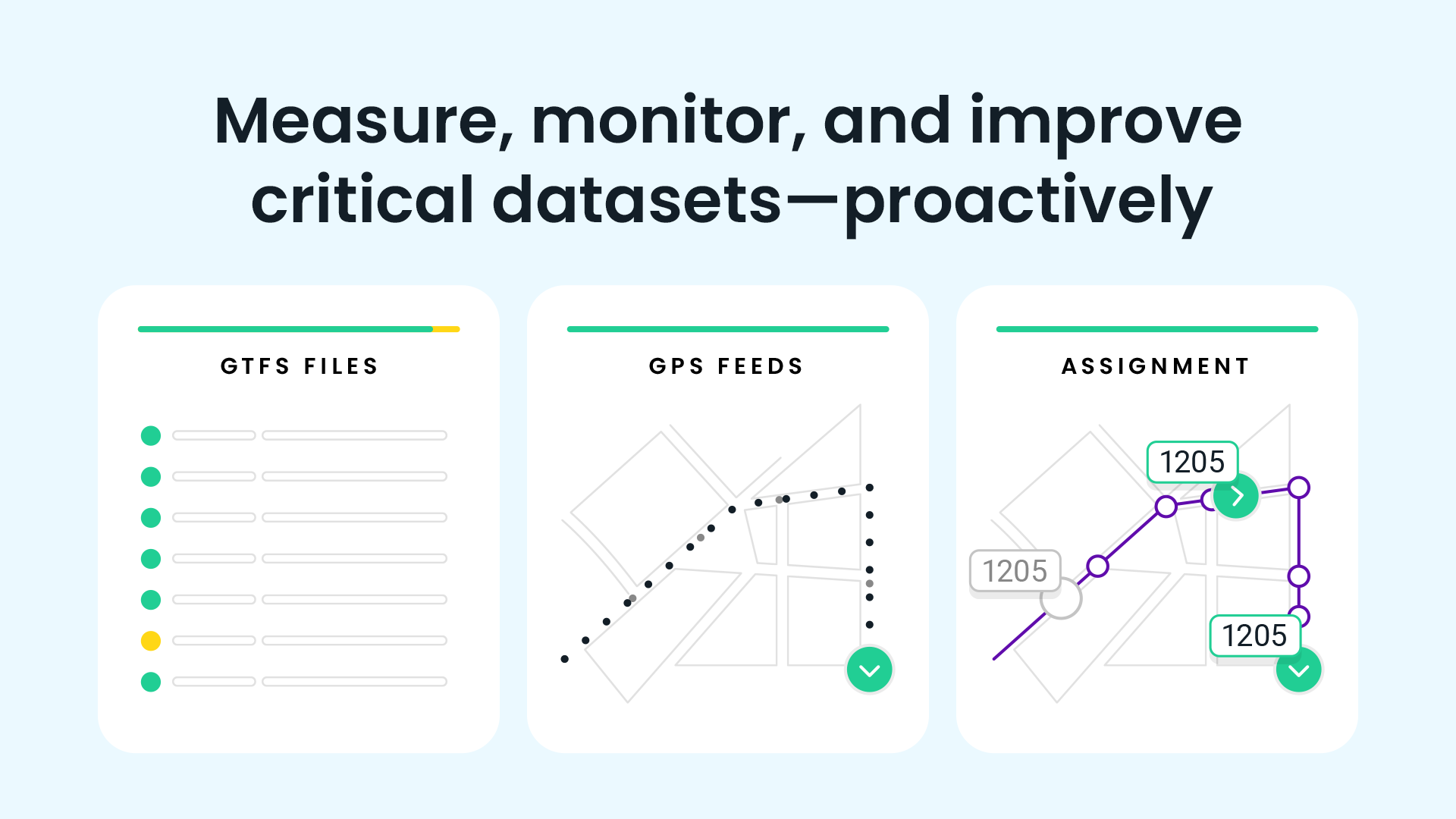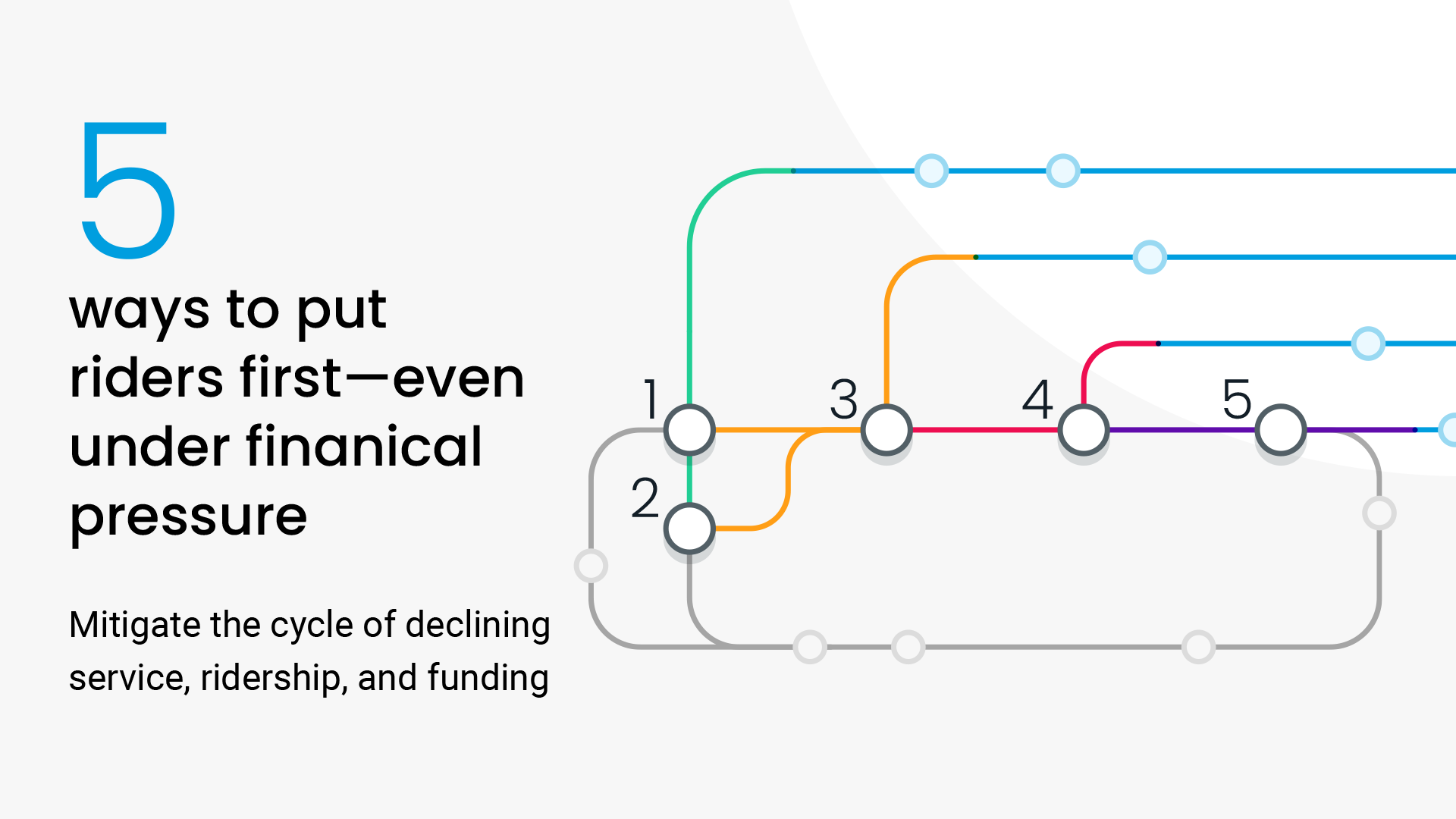
December 14, 2023
3 lessons from hundreds of data therapy sessions

December 14, 2023
3 lessons from hundreds of data therapy sessions
December 14, 2023
3 lessons from hundreds of data therapy sessions
As a Solutions Engineer at Swiftly, I get to work with transit professionals in North America (and beyond) to help them use Swiftly to fix some of their most pressing problems. I’ve found that for many transit agencies, the inability to improve customer satisfaction, attain service reliability goals, and improve interdepartmental coordination, are all symptoms with the same underlying root cause: bad data.
I often hear from agencies that they don’t trust their data and that staff spend more hours cleaning data or reconciling data between different systems, than actually analyzing data. In the last several years, the transit industry has shifted away from relying on schedule adherence data derived by CAD/AVL systems, and for good reason.
As a Transit Data Platform, Swiftly works with feeds from every CAD/AVL vendor and many on-board device vendors and has analyzed billions of raw data points. Swiftly has developed unique capabilities to enrich an agency’s underlying data quality and streamline areas of inefficiency as they relate to real-time and historical reporting; for both internal operations and customers. As one CIO noted: “Swiftly is like a data therapist.”
Let’s walk through the key data quality issues I see and how Swiftly has helped other agencies improve the accuracy, reliability, resilience, and completeness of real-time and historical data.
Lesson 1
Take out the trash: Moving to high-fidelity data
I frequently work with transit agencies who struggle with poor real-time information and historical reporting rooted in a classic data problem: garbage in, garbage out. Even an expert analyst or an optimized algorithm will produce bad results if the incoming data is poor.
Automatic Vehicle Location (AVL) data is a core data input for transit. Bad data inputs (i.e. “garbage in”) typically stem from two common AVL issues:
- Infrequent AVL—greater than every 30 seconds. Many existing systems have hardware, software, or networking limitations that prevent them from generating frequent AVL data.
- No AVL. Issues like broken equipment can cause AVL data to be missing for a vehicle, while issues like system outages or security incidents can cause AVL data to be missing for the entire fleet.
The bad output data, i.e. (“garbage out”) generated from these AVL issues can impact transit data in several ways:
- Inaccurate or incomplete critical performance metrics—such as on-time performance, service delivery, and run-times.
- Poor customer experience from inaccurate predictions and vehicle tracking.
- Missing real-time and historical information due to CAD/AVL outages.

How Swiftly can help:
Swiftly can improve a transit agency’s underlying data through its unique capability to ingest multiple sources of AVL, and use them in combination, at no additional cost. Many onboard devices can generate AVL including wifi routers, cameras, Automatic Passenger Counting (APCs), etc. There is no limit to the number of feeds that Swiftly can ingest for an agency; for one agency we combine data from seven different feeds. Swiftly is currently integrated with well over 100 hundred supplementary AVL feeds from our customers’ various onboard devices. These devices can be configured to forward data to Swiftly to improve data frequency. When combined with Swiftly’s algorithms, this results in more accurate real-time predictions and historical data. For example, when Capital Metro turned to Swiftly to combine multiple AVL feeds, its AVL frequency went from over 1 minute to under 10 seconds. Similarly, Pierce Transit’s legacy system updated AVL every 2 minutes, but Swiftly leveraged existing onboard equipment to improve AVL frequency to every 10 seconds.
Multiple data feeds lead to data resilience during a feed outage. One Swiftly customer suffered a CAD/AVL malware attack, but Swiftly was able to continue to generate GTFS-rt for riders and provide operational staff with fleet visibility. Another agency was able to generate predictions using Swiftly when their CAD/AVL went down due to the 3G transition.
Lesson 2
Filling in data gaps from log-in issues
Even a high-quality AVL feed can quickly be rendered obsolete if there is no information about what trip or block the vehicle is assigned to. Unfortunately, many agencies encounter assignment issues due to faulty hardware, operator login error, or delays in loading trip information following a service change. It’s not uncommon for an agency’s operator log-in rates to hover around 75%, sometimes as low as 50%.
The result?
- Missing passenger information. When a vehicle is missing assignment information, passengers will just see the schedule and not have any real-time information available.
- Incomplete OTP data. This can impact an agency’s ability to achieve OTP goals. You can’t fix what you can’t measure.
- Inability to track service delivery. This can impede an agency’s ability to do National Transit Database (NTD) reporting, track missed trips, and monitor service delivery for contracted operators.
How Swiftly can help:
Swiftly is able to fix assignment problems through a feature called auto assigner. When assignment data is missing, Swiftly’s algorithms match an unassigned vehicle to a trip, resulting in updated vehicle locations, prediction times, and complete historical data. For the customer, this means they can suddenly have tracking and predictions for a bus they would otherwise not know is en route. For agency staff, we collect 10-20% more historical data at stops and timepoints.

Request a demo
Lesson 3
Geofences: A thing of the past
A transit analyst expressed frustration that their agency was consistently falling short of achieving its on-time performance goal for a popular route, causing confusion and blame-shifting among dispatchers, operators, and schedulers. I reviewed their on-time performance metrics in Swiftly and verified the results with raw location data from their AVL. I discovered that the agency had, in fact, achieved the route’s on-time performance goal. So why wasn’t their reporting reflecting this?
The arrival and departure times for a vehicle at a stop are the fundamental building blocks of historical data, but often this data is recorded incorrectly. CAD/AVL systems record a vehicle as having arrived or departed when a vehicle crosses or “breaks” a geofence (sometimes called a trigger box). Geofences are notoriously error-prone, particularly at terminals. For example, if a vehicle departs a stop at 7:00 am but does not break a geofence for an additional 2 minutes (maybe because it is held at a traffic signal) then the vehicle will be recorded as having departed at 7:02 am. This is exacerbated due to cases of vehicle looping, bus bunching, delayed log-ins, and vehicle swapping.

Based on our work with dozens of transit agencies, we found that:
- Geofences can result in on-time performance data that is up to 15% inaccurate.
- Inaccurate terminal arrival and departure times can result in run-times that are up to 30% shorter or longer, causing ill-informed schedules.
- Staff may spend hours manually data cleaning to remove faulty data, or conducting additional, time-consuming ride checks.
- The inaccuracy and unreliability of OTP data often result in miscommunications across teams, as well as contractor and/or operator disputes.
How Swiftly can help:
Swiftly doesn’t use geofences to determine stop arrivals and departures. Instead, we look at surrounding GPS data and historical data and apply our algorithms to determine the most accurate arrival and departure estimates. When we ground-truth our arrival/departure times, our methodology results in more accurate data.

The result?
- More accurate OTP reporting. Determine true early, late, and on-time performance.
- Data-informed schedules. Correct terminal arrival and departure times result in accurate and complete run-times data.
- Liberated staff time. Less staff time cleaning data, more staff time analyzing data.
- Accurate source of truth. Operations and planning teams speak the same data language.
Swiftly’s arrival and departure methodology was recently piloted by staff from Transdev, the largest private operator of public transit modes. After analyzing and comparing OTP data from their other system and Swiftly, they determined that Swiftly was more accurate and was not impacted by the errors caused by geofences.
“We were experiencing some significant discrepancies in our OTP. Swiftly’s system, which doesn’t require geofencing, showed us numerous areas that needed to be addressed with our current system,” said Scott Germann, Vice President of Operations, Central Region, Transdev North America.
“Switching to Swiftly was our ultimate goal, but wow what a difference using their technology made to understanding and measuring our OTP. I definitely recommend this over traditional geofencing. It’s like driving a 2023 car with loaded tech versus an early model 2000. What a difference!”
At Swiftly, we know data needs to be accurate to be powerful, and we’re committed to bringing high-quality data to agencies worldwide to share real-time passenger information, manage day-to-day operations, and improve service performance. Outdated geofences, low-quality AVL data, and operator log-in issues are just a few of the challenges that keep agencies from accessing good data. Swiftly customers, over 150 transit agencies in 8 countries—including LA Metro, MARTA, Tucson Sun Tran, and RTC of Southern Nevada—rely on Swiftly to improve on-time performance by up to 40% and increase passenger information accuracy by up to 50%.
Ready to improve your agency’s data? Get in touch.
The rich text element allows you to create and format headings, paragraphs, blockquotes, images, and video all in one place instead of having to add and format them individually. Just double-click and easily create content.
Last Name, Agency

What’s a Rich Text element?
What’s a Rich Text element?
What’s a Rich Text element?
What’s a Rich Text element?
What’s a Rich Text element?
The rich text element allows you to create and format headings, paragraphs, blockquotes, images, and video all in one place instead of having to add and format them individually. Just double-click and easily create content.
Last Name, Agency
Static and dynamic content editing
A rich text element can be used with static or dynamic content. For static content, just drop it into any page and begin editing. For dynamic content, add a rich text field to any collection and then connect a rich text element to that field in the settings panel. Voila!
How to customize formatting for each rich text
Headings, paragraphs, blockquotes, figures, images, and figure captions can all be styled after a class is added to the rich text element using the "When inside of" nested selector system.
- text goes here
- text goes here
- text goes here
- text goes here
- text goes here
- text goes here









